Introduction
Labor is the key factor for the growth of any economy and is of particular importance in developing economies as these economies primarily depend on human force for development. Therefore, the growth by way of gainful employment of the labor is essential for the sustainable development. India is no exception to this phenomenon. The annual growth of labor force at 2.5 per cent has outpaced that of employment at 2.3 per cent in India. This, coupled with the backlog of unemployed, is a major cause of concern for the planners. The unemployment rate in the country increased from 8.35 to 9.22 per cent during 1973 to 1983; later decreased to 6.06 by 1993 and again increased to 8.28 per cent in 2005 (Planning Commission, 2011). There was increase in the unemployment rate at the country level especially among female youth during the period 1999-2000 to 2004-2005 (Table 1). At the same time, in states like Andhra Pradesh and Maharashtra, the female unemployment rate has come down during this period. This could be partly attributed to the growth of community institutions like self-help groups (SHGs) in these states with as high as 30 percent households being part of the SHG movement in states like Andhra Pradesh (Fouillet and Augsberg, 2007; Fernandez, 2007). Other reasons include relatively higher female literacy in Maharashtra (65 %) compared to national average of 54 percent and increasing female participation in agricultural operations. Of the estimated total work force of 400 million in the country, 93 per cent is employed in the unorganized sector, of which agriculture is the dominant segment (Shaktivel, 2006). An estimate by Economic Census of India puts the employment in non-agricultural establishment in rural India at 41.9 million in about 19.8 million establishments. Retail trade (39%) followed by manufacturing (26%) account for the largest share in the rural non-agricultural employment. The labor force participation rate (LFPR) is another major indicator that denotes the actual share of able bodied who actually participate in economic activities. At the all India level, the LFPR was 51.4 percent and in states like Andhra Pradesh, Karnataka and Rajasthan, this was above the national average. In Maharashtra, it was around 49 percent. Further, the alarming statistic is that the rate of unemployment growth was 9.9 percent at the all India level in 2010, while in two of the four states it was below half that of the national level (Table-2). Alarmingly the unemployment growth was over 20 percent in 2010 in the state of Rajasthan. These statistics together indicate that unemployment is a concern and that needs to be tackled by the government.
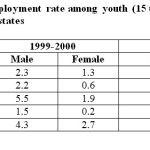 |
Table 1: Estimates of unemployment rate among youth (15 to 29 years) in rural areas of India and some states. Click here to View table |
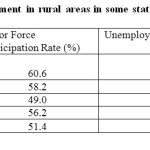 |
Table 2: Unemployment in rural areas in some states and India,2009-10. Click here to View table |
Lack of adequate employment opportunities generally induces migration from rural to urban areas. In India, internal migration has been accorded very low priority by the government, partly due to a serious information gap on its extent, nature and magnitude. As per the 2001 Census, the total number of internal migrants was 309 million or nearly 30% of the total population (Bhagat, 2011). The number of migrants in the country was as high as 244 millions in the year 2003 of which migrants from rural areas accounted for over two-thirds. Nearly 8.5 per cent of the migration is on account of lack of employment (IAMR, 2003). Rural to urban migration to a certain extent has eased the unemployment stress in rural areas while benefiting the urban areas in sectors like construction and industrialization. However, seasonal unemployment, under-employment and resultant poor income levels in the rural areas remain a cause of concern. Unemployment, especially among the landless and small farmers who have very poor asset base accentuates during drought years, particularly in rainfed agriculture dominated regions. Therefore, it was imperative that the State had to take a strong policy initiative to restore the balance. This was why the National Rural Employment Guarantee Scheme (NREGS, later named after Mahatma Gandhi to be called as MGNREGS) was initiated by the government of India during 2006 (MoRD, 2005).
Ever since the scheme came into existence several studies have been conducted which primarily focused on the extent of employment/ income security, change in the life styles and flaws in the implementation of the scheme (Ambasta et al ,2008 and Dreze,2009, ), Study by Basu (2011) has given a theoretical framework for the evaluation of a number of observations and empirical results on the impact of an NREGS on agricultural wages, employment and output, and underscores the importance of the relative productivity of workers in the Scheme program vis-à-vis their counterparts engaged in agricultural production in determining the success of these programs. Similarly a study by NCAER and PIF (2009) covered as to how well the NREG act is being implemented in various parts of th3e country, what are the main constraints faced by the implementing agencies, how the communities have participated, what type of works are undertaken and how effective they are etc. the study also suggests further areas of research like end use of the wage earnings, utility and effectiveness of the assets created under the scheme. Hence a study was taken with the objectives like impact of the scheme on the livelihoods of wage employees, wage rate changes in the rural areas and the status of assets and their use by the farmers and the communities in general. The present study is aimed at pointers for effective scheme implementation for poverty reduction, food security, use of earnings , and impact on agriculture especially in terms of labour wages.
Materials and Methods
To examine the impact of NREGS on rural employment, a study was conducted in during the period 2008-2010 in four key states viz., Andhra Pradesh, Karnataka, Rajasthan and Maharashtra of India, in terms of its implementation besides being endowed with large rainfed areas. For the survey and field work, one district, with larger number of works undertaken as part of NREGS, from each was selected. From each district, three mandals / blocks (administrative sub divisions of the district) were selected randomly and from each of them two villages were selected randomly. The key demographic and agricultural characteristics of the sample districts are presented in the annexure. Within the village, employment beneficiaries (those who obtained wage employment in the Scheme works as mandated under the scheme) , farmers in whose lands the natural resource management works are taken up, equal number of farmers who did not get any such work benefits under the scheme and work sites for physical verification were selected and studied using pre-tested interview schedules.
A total of 240 employment beneficiaries under NREGS and 288 farmers were interviewed for the study from the above four states. Considering the scope of this paper, the analysis and inferences are limited here to the sample lot of employment beneficiaries and the secondary data only. Similarly, secondary data were collected from the websites www.nrega.nic.in; www.nrega.ap.gov.in and from the state line departments. The raw data collected from primary and secondary sources was treated or analyzed using simple averages, percentages and t test for comparison among the sample units.
Results and Discussion
Progress of NREGS
The genesis of the scheme (NREGS) can be traced to the Maharashtra employment guarantee scheme introduced during 1970s, about which Mahendradev (2002) and Herring and Edwards (1983) opined that the objective and subjective interests of the rural poor were met by the scheme.
Regional Coverage of NREGS
Various categories of works that generally enhance the capability of natural resources like soil, water bodies, plantations, irrigation facility, drought resistance/ flood control, roads to connect the rural areas etc are taken up under the scheme.
NREGS was originally launched in February, 2006 in 200 districts and was subsequently extended to another 130 districts in 2007-08. Currently the scheme is in implementation in all the 593 rural districts of the country. It is an entitlement scheme guarantees to provide 100 days of employment to all those rural households who demand work. During the six years ending March 2012, about 7.641 billion person days of employment has been generated with a budgetary support of almost INR () 1000 billion during this period (NREGA. 2012). Some studies on the benefits of NREGS and its implementation modalities have been undertaken by Ambasta et al., (2008) and Dreze (2009). However, the specific information on impact of the scheme on livelihoods, is hardly available, but would be important to further strengthen the scheme. This study attempts to assess the impact of the scheme on rural livelihoods with focus on employment and wages, especially in predominantly rainfed areas of India. Before the impact assessment results an overview of the scheme’s progress so far is presented.
State Wise Works and Expenditure
The scheme focus being improving the status of natural resources through soil and water conservation and thereby enhancing the productivity of such lands, it is natural that the works are concentrated in certain regions/ states with more such need. Thus, the predominantly rainfed states together accounted for almost 76 percent of the funds under the scheme (Table- 3). The maximum number of works in the case of Uttar Pradesh is due to more number of work items like rural connectivity (i.e. roads), rather than direct natural resource management works.
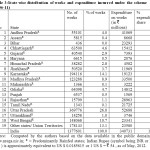 |
Table 3: State wise distribution of works and expenditure incurred under the scheme (2006-11). Click here to View table |
Employment Generation
The scheme has provided employment to 10.6 million households in the year 2007-08, which scaled up to over 53.47 million by the year 2010-11 and slightly dropped to about 50 million households by the year 2011-12. This is a staggering figure considering that the total rural households in India are 138 millions, which accounts for about 36 percent coverage. Women obtained 46.5 per cent of the wage employment during 2010-11 indicating greater gender equity in rural areas. Women got still higher employment opportunities in states like Tamil Nadu (77%) and Rajasthan (68%). This indicates that the scheme has empowered the women by providing greater employment opportunities (Dasgupta and Ratna, 2010). However, even after almost five years of its implementation i.e. by 2010-11, only 7.5 percent of the households got the promised 100 days of employment. Across the states, Andhra Pradesh and Odisha have been able to provide employment for 100 days to a relatively larger proportion of households (Table 4). On an average, the annual employment generated worked out to 11 person days for the families covered by the scheme. This is presumably due to poor demand for work, besides less enthusiasm for continuous engagement and low preference for the types of works offered under the scheme.
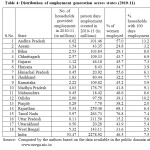 |
Table 4: Distribution of employment generation across states (2010-11). Click here to View table |
Following are the results of the study conducted across the four states probing into the coverage and penetration of the scheme and its impact on the poverty and livelihood status:
Results from Regional Village Studies
The Anantapur, Udaipur, Yavatmal and Bellary districts, respectively represented the selected states in the study sample. A comparative status and impact of NREGS, especially with respect to employment and wages across the study villages in the selected districts of four sample states is presented and discussed in this section.
Profile of Employment Beneficiaries
The profile of the beneficiaries revealed that farmers outnumbered the landless in all the districts barring Udaipur (Table 5). This indicates that the scheme has been particularly useful to the resource poor farmers who otherwise might have stayed unemployed or underemployed. Among the farmers’ category, the marginal and small farmers took advantage of the scheme for augmenting their livelihood sources. However, in agriculturally distressed districts like Anantapur and Yavatmal, even the farmers with larger holdings (>2 ha) under rainfed conditions also participated in NREGS as wage earners.
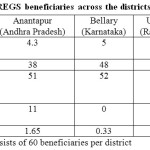 |
Table 5: Profile of the NREGS beneficiaries across the districts. |
Migration Status
Distress migration among marginal farmers and farm labor from rainfed and drought prone areas to urban areas and projects is a serious concern. Schemes like NREGS by providing local opportunities through manual works can mitigate the migration (Table 6). Post NREGS, the migration level has come down drastically across the sample districts, the highest being in Anantapur. Accordingly, the income from migration also decreased during NREGS period compared to the pre-NREGS period and the values were statistically significant (at 0.05 alpha level). Besides, it brought about qualitative life changes by avoidance of dislocation and higher cost of living and enhanced enrollment of children in schools. Deshingkar and Frrington (2008) had studied the migration trends in south Asia and emphasized the need for effective welfare schemes to handle the distress migration and hence this scheme has shown that it can bring down such distress. The study of course does not fully attribute the changed migration status only to NREGS, as several other developments like a new irrigation project in a state like Andhra Pradesh in some parts of the state has drawn back the people on migration in urban areas to the villages, similarly other welfare measures of the state
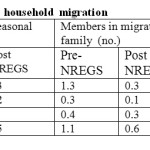 |
Table 6: Impact of NREGS on household migration. Click here to View table |
Household Employment and Share of NREGS
The number of days of employment for the wage seekers was the highest in Anantapur with 423 person days per annum per household. The share of NREGS employment was also the highest (30%) in Anantapur district followed by Yavatmal. Employment obtained in NREGS per household was also the highest in Anantapur district compared to the other three districts. Nevertheless, the largest share of the work opportunities was available through agriculture, allied and self-employment. Employment in NREGS was crucial because it was available in the lean season when other employment opportunity was hardly available (Table 7 & Fig.1). Women obtained employment in NREGS more or less on a par with their men counterparts. Similarly, opportunities for them in other rural activities were on a par with that of men, except in Udaipur. In fact, women’s access to wage employment increased significantly after NREGS, however the number of days of employment are not significantly different from their men counterparts, at the best they were on par. Women are generally hired as agricultural labor for some specific activities, however, under NREGS, men and women could participate equally. Many unemployed and under-employed small and medium farmers, who did not opt to work as agricultural labor in the fields of other farmers on account of social inhibitions, also participated actively under NREGS and got gainful employment for better livelihood security.
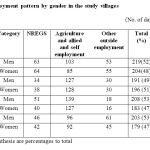 |
Table 7: Employment pattern by gender in the study villages. Click here to View table |
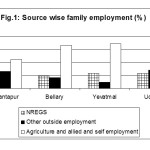 |
Figure 1: Source wise family employment (%). Click here to View figure |
Household Income vs. NREGS Earnings
NREGS earnings significantly contributed to the household income. The annual household income from all sources was the highest ( 62,357) for the wage seekers in Bellary district while it was the least ( 25,893) in Yavatmal district. Agricultural wages constituted the major source of livelihood in three out of the four study districts with an exception in Anantapur, where NREGS wages accounted for the major share (33%) of family income (Table 8), the district incidentally has major part of its area under drylands. This indicates that the need for NREGS works is higher in pre-dominantly rainfed districts. NREGS wages accounted for a share of 12-18 per cent in the other three states. In Udaipur district non-agriculture labor, especially construction work in the nearby urban areas provided a considerable share of family income compared to the other three districts. The contribution of NREGS wages which was 3884 to 14263 per household per annum across the districts, significantly influenced the livelihood security especially for the landless rural households and resource poor farmers.
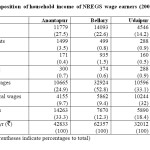 |
Table 8: Composition of household income of NREGS wage earners (2008-09). Click here to View table |
Impact on Agricultural Wage Rates
Agricultural labor supply in India increased significantly from 56 million during 1981 to 107 million during 2008. At the same time, the share of operational land holdings under small and marginal farmers (< 2 ha) raised from 70 per cent in 1971 to 82 per cent in 2001. These small holdings in most parts of the country do not prove self sustainable production units. Hence, the policy response to a situation of poverty and inequality has focused on inclusive growth. The architecture of inclusive growth is defined by prioritizing key result areas through major programmes aimed at time-bound delivery of outcomes, namely, infrastructure (rural roads, housing, electricity and water sanitation), human resource development through basic education, and health and livelihood through skills development, income-generation and especially a wage employment programme (UNDP, 2011).
A massive rural employment opportunity through NREGS is bound to have effect on the demand and supply of labor and also on their wage rates. Therefore, the prevailing farm wage rates existing before and after the launch of NREGS were obtained through focus group discussions and directly from the farmers through personal interviews. A comparison of agricultural wages for the pre NREGS period (2005-06) and the NREGS period (2006-08) obtained in the study villages of sample districts is presented in Table 9. The wages have generally increased both in the peak as well as slack seasons with marginally higher growth rate during peak season. Among the sample districts, the highest annual increase was noted in Anantapur, which ranged from 33 to 39 per cent per annum.
Comparatively, the pre-NREGS benchmark wage rate was considerably higher in Bellary. Accordingly, the annual wage hike in Bellary was only 21-26 per cent across seasons and gender. The increment in agriculture wage rate during the NREGS period was higher for the female labor (up to 31%) in Udaipur district compared to their male counter parts. That shows the impact of NREGS by way of rationalization of wage rates across gender. The annual average wage hike was in the range of 24-29 per cent in Yavatmal district primarily as a consequence of NREGS implementation. On a statistical analysis, it was noted that the wage hike was significant in three of the four sample districts with an exception in Yavatmal district, especially during the peak season. In the off season, although there was general rise in wages, it was not statistically significant. During our recent interactions with the farmers in Andhra Pradesh, Karnataka and Rajasthan (2009-10), it was observed that the agricultural wage rates have increased up to 250 per day per person. A comparison of the general wage hike, the influence of NREGS and the state policy of minimum wages across the states in India is presented in fig.2. It may be noted that the wages are paid under the NREGS at a minimum which are fixed on a yearly interval and the wages are calculated based on the earth work or other manual work turned out by the people engaged. It was also noted that the correlation between the NREGS wages and the market wage rates was positive. Across the sates, the extrapolated market wage rates for agricultural laborers, were higher (30%) compared to the least increase (10%) in Rajasthan. The significant increase in rural wage rate has benefited the wage earners. At the same time, higher cost of production due to higher labor wages is affecting the economy of farmers negatively. Hence the farmers in many cases are opting for less labor intensive crops or other enterprises. The increasing wages coupled with timely non availability of labor are also inducing mechanization of some of the farm operations.
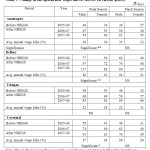 |
Table 9: Change in the agricultural wages due to NREGS (at current prices). Click here to View table |
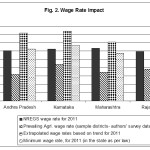 |
Figure 2: Wage rate impact. Click here to View figure |
Another fall out of the scheme was that many self help groups (SHGs) formed earlier to encourage group based rural enterprises, especially in Udaipur district, have started disintegrating, as pointed out in the focus group discussions. Since people got easier option of employment in the form of NREGS, it appears that they do not want to make efforts for building SHGs and other community based organizations for taking up self and or collective employment activities, where more efforts and risk are involved.
In fact, a job card holder can get a maximum of 100 to 150 days of work under NREGS still leaving 215 to 265 days to work elsewhere. Even if we take out 50 days for leisure, a person still has 165 to 215 days to work for activities other than NREGS. In rainfed areas which have only one major cropping season in kharif (monsoon cropping season in India- June to October), the duration of labor requirement for agricultural operations is not more than 4-5 months. In spite of this, shortage of labor for farm operations after introduction of NREGS is reported even in rainfed areas. As mandated in the scheme, the gram sabha (village council), has to decide on the type and timings of the works to be undertaken in NREGS and may very well plan the NREGS work of 100-150 days in a year so that no NREGS work except emergencies is taken up during the peak agricultural seasons. However, in practice, the gram sabha is rarely called to decide on NREGS activities. In many villages, even sarpanches / pradhans (elected heads of village council) are consulted for the sake of formality and the timings and activities to be undertaken under NREGS are decided by the Technical Assistant and Block / Mandal Level Officer concerned. The issue of labor shortage may be addressed to a greater extent by improving the functioning of NREGS by keeping the window of NREGS employment in such a way that it does not clash with peak agricultural operations. But, there would still remain shortage of labor for agricultural operation under post NREGS scenario. Hence, there is need to improve the functioning and enlarge the scope of NREGS in order to mitigate the labor shortage for agriculture. It is pertinent to mention that agricultural operations have been brought under the ambit of eligible works category for NREGS in Kerala with the cultivator has to pay the difference between the NREGS wages and the market wages to the labor. As a fall out of farmers’ outcry and on recommendations of researchers the government of India has since reviewed the Scheme and has enhanced the scope of works by adding agricultural and community works like Nadep/ vermin-composting, poultry/ cattle shelters, fisheries in seasonal water bodies etc. This will not only broaden the work domain but also increase the livelihood opportunities for the rural communities (NREGA, 2012: www.nregs.nic.in; Kareemulla et al., 2010).
Implications
Rural Poverty
Poverty is a manifestation or a symptom of complex factors in a society. India is one of the hot spots of poverty. Therefore, state efforts through welfare schemes like NREGS will certainly have some impact or the other on poverty reduction. Besides, growth and development on account of various factors, the scheme seem to have had a certain impact on reducing the poverty with almost a reduction of almost 1.5 per cent annual reduction in the poverty level in the country (Table-10).
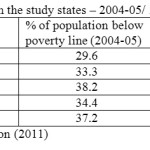 |
Table 10: Poverty levels in the study states–2004-05/ 2009-10. |
To support the argument that the reduction in poverty levels, whose concentration is more in rural areas due to higher population base over there, can be primarily ascribable to growth in agriculture there is no clear evidence (table -11). However, inclusive growth will and can only happen with overall policy response by way of schemes that can benefit all the sections of the society including labor. Probably this has been evidenced here. Although the agricultural growth was significantly lower in three out of four states in the latter triennium (2006/07-2008/09), that coincides with the NREGS period, obviously the earnings seemed to have spurred consumption expenditure of the households, resulting in the reduction of poverty, of course supplemented by several other welfare measures such as food security through public distribution for the poorer sections of the community and other schemes.
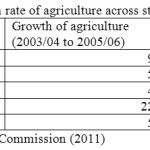 |
Table 11: Average annual growth rate of agriculture across states. |
Use of NREGS Earnings – Food Security and other Amenities
Now to inquire in to the actual use of the wage earnings from NREGS, the household interviews held with the wage beneficiaries gave the following insights (Table-12 & fig.3). Majority of the scheme wage earners used the wages for food security and the other two uses were education of their dependents and securing health. In Udaipur the food security was the prime use of the earnings outweighing all other uses put together.
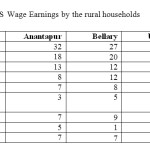 |
Table 12: Use of NREGS Wage Earnings by the rural households. Click here to View table |
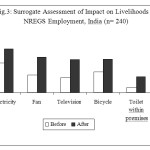 |
Figure 3: Surrogate Assessment of Impact on Livelihoodsdue to NREGS Employment, India(n= 240). |
A study by Ravi and Eagler (2009) suggested that improvements in food security, increased instances of savings, reduction in anxiety levels etc. Similarly Dreze and Khera (2009) indicated that 61 % of NREGS beneficiaries were illiterate, 72 % did not have electricity in their homes. Half of such people said that the scheme has changed their lives and 69 % said that it helped them avoid hunger. Thus, the present study results confirm the past inferences.
Food security has three components – availability of food in the market, access to food through adequate purchasing power, and absorption of food in the body. Livelihood and employment guarantee schemes are likely have impact on the second component which is enhancing the capacity to purchase the food. The MS Swaminathan Research Foundation (MSSRF) and World Food Programme in the food insecurity study of rural population across the states in India confirmed that in states like Karnataka and Maharashtra, the share of population with lower food intake was higher, compared to Andhra Pradesh and Rajasthan, among the four states the focus of the present study (Table-13). This is more a problem of affordability than the availability due to lack of means or purchasing power. Similarly, in all these states, there was acute shortage of basic amenities like drinking water and toilets in the proximity. Hence, it is expected that welfare schemes, which provide earnings lead to affordability of one or many of these necessities.
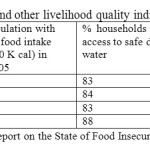 |
Table 13: Food insecurity and other livelihood quality indicators of select states. Click here to View table |
In terms of the income estimated from the village surveys of the present study it may be seen that there is an increase of food security, commensurate with the income increase in all the four states, with significant increase in Anantapur and Yavatmal among the four districts (Table-14). It may be worth noting that the gap between the rich and the poor widened between the two reference periods with the MPCE across the consumer categories varying a lot (ASSOCHAM, 2012). This argument has also been affirmed by other studies (Financial Express, April 10, 2010; Reddy et al.,2010).
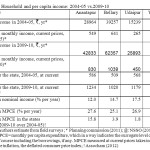 |
Table 14: Household and per capita income: 2004-05 vs.2009-10. |
Conclusions
The National Rural Employment Guarantee Scheme now renamed as Mahatma Gandhi NREGS which was primarily aimed at guaranteeing employment for the rural poor has been able to generate employment and make a dent on poverty in the rainfed areas of India. The present study which was conducted at micro level in four major states viz., Andhra Pradesh, Karnataka, Maharashtra and Rajasthan brought out the following lessons from the view point of people who obtained seasonal employment under the scheme.
- The observation that a significant proportion of farmers participated in the programmes for wage earning highlights the eroding profitability of agriculture in general and the need for gainful employment even to the farmers. The positive income and employment effects on the landless households are on the expected lines.
- Introduction of a large scale scheme like NREGS has significantly brought down the migration levels in rural areas, thus, retaining the rural labor for use in the local areas. As the major possible works in the villages get exhausted, new and innovative works need to be found out not only to retain the rural labor, but also to provide productive employment minimizing the need for such programmes in the long run.
- The wage earnings from the Scheme have been used mainly for meeting expenses toward food, education of the dependents, health care etc indicating that it has helped in bringing down poverty in rural areas. The indicators of monthly per capita expenditure for the pre and during the NREGS period also point to significant raise in the living standards of the rural populace, in the states where the scheme was implemented on a large scale. This clearly implies that in a country where food availability is not an issue, but when purchasing power is augmented, definite impact on poverty is assured.
- Implementation of NREGS has led to a faster rise in the farm wage rates. The wage hike was relatively higher in respect of female labor in Rajasthan, thus narrowing wage disparity across gender. Therefore, it may be inferred that the regulated wage rates under the scheme have significantly influenced the general agricultural wage pattern in India
- Although it is a common knowledge that during peak agricultural seasons, there will be a mismatch between the labor supply and demand, introduction of NREGS has certainly widened this gap. Obviously, due to labor scarcity and higher wages, the farmers have been compelled to either postpone or stagger the agricultural operations. In some areas the manual post-harvest operations have been substituted by mechanical means. This may intensify over a period of time. In agriculturally intensive areas, the labor situation may be complicated where crops like sugarcane are grown which are mostly dependent on manual labor for operations like harvesting. In some cases, it was observed that the ‘demand for leisure’ also increased, accentuating the labor scarcity for farm operations.
- Thus it may be stated that the scheme has in a way brought in a paradigm shift in the rural labor opportunities and livelihoods in India. Sustaining the momentum depends to a large extent on innovations in work opportunities, organization of the labor force and community planning and execution with greater involvement of the farmers at all stages.
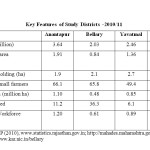 |
Annexure I: Key Features of Study Districts -2010/11. Click here to View Annexure |
Acknowledgements
The study formed part of a project that assessed the impact of NREGS on Agriculture and was partially supported by the World Bank funded National Agricultural Innovation Project titled V-PAGE operated by National Centre for Agricultural Economics Policy and Research, New Delhi
References
- Ambasta Parmatesh, Vijay Shankar, P. S. and Shah Mihir (2008). “Two years of NREGA: The Road Ahead”. Economic & Political weekly – February 23-29, 2008, 43(8): 41-50
- ASSOCHAM.(2012). Rural Development in India: State Level Experiences. The Associated Chambers of Commerce and Industry of India. New Delhi. p.35
- Basu. K Arnab. (2011). mpact of Rural Employment Guarantee Schemes on Seasonal Labor Markets: Optimum Compensation and Workers’ Welfare Discussion Paper No. 5701. College of William & Mary,ZEF, University of Bonn and IZA. P. p.41
- Bhagat, R. (2011). “Internal Migration in India: Are the Underclass More Mobile?” in S. Irudaya Rajan (ed) Migration, Identity and Conflict – India Migration Report 2011 (New Delhi: Routledge)
- CSO.(2010).Central Statistical Organisation, Ministry of Statistics and Programme Implementation, Govt. of India. (1996-97 to 2008-2009)
- Dasgupta, Sukti; Sudarshan, Ratna M.(2010). Issues in labor market inequality and women’s participation in India’s National Rural Employment Guarantee Programme / Sukti Dasgupta and Ratna M. Sudarshan ; International Labor Office. – Geneva: ILO, 2010 1 v. (Working paper ; 98)
- Deshingkar Priya and John Farrington. (2008). Rural Labor Markets and Migration in South Asia: Evidence from India and Bangladesh Background Paper for the World Development Report 2008 .p27
- Dreze, Jean.(2009). “NREGA is not artificial employment”. Civil Society. May 2009 : 7-8
- Dreze, Riteeka Khera .(2009). The battle for employement gurarantee. Frontline vol 26. no.1.
- Fernandez, A.P. (2007).History and spread of the self-help affinity group movement in India The role played by IFAD. Discussion paper- 3. IFAD. p.38
- Financial Express.( 2010). NREGA hits rural poverty, 26 Apr. www.financialexpress.com /news/nrega-hits-rural-poverty/611525
- Fouillet Cyril and Britta Augsburg.(2007). Spread of the Self-Help Groups Banking Linkage Programme in India. International Conference on Rural Finance Research: Moving Results. FAO Headquarters. Rome, Italy 19-21 March 2007
- GoI, (2005). “Rajya Sabha unstarred Question No.2375” dated 13th December, 2005
- GOI, 2010. Report on Employment & Unemployment Survey: (2009-10). Ministry of Labor and Employment. Labor Bureau, Chandigarh. P.160
- Herring, R. and Edwards, R. M. (1983) “Guaranteeing employment to the rural poor: Social functions and class interests in the employment guarantee scheme in western India”. World Development, 11(7): 575-592.
CrossRef - IAMR (2003). “Year Book, 2003”, Institute of Applied Manpower Research. Delhi
- Kareemulla, K., Shalander Kumar K. S. Reddy, C.A. Rama Rao, and B. Venkateswarlu.(2010) . Indian Journal of Agricultural Economics. Vol. 65, No.3, 2010, pp.524-539
- Mahendradev, S.(2002) Employment Guarantee Scheme in Maharashtra: Lessons for Development Policy. Centre for Economic and Social Studies, Hyderabad, 25 p
- MoRD.(2005). The National Rural Employment Guarantee Act, 2005 (NREGA): Operational Guidelines (2008) 3rd Edition, Ministry of Rural Development, Government of India, New Delhi, 194 p.
- MSSRF & WFP,(2008) Report on the State of Food Insecurity in Rural India MS Swaminathan Research Foundation. .p.242
- NSSO. (2011).Key Indicators of Household Consumer Expenditure in India, 2009-10. National sample Survey Organization, Government of India. p.7
- NCAER. (2009). NCAER-PIF study on Evaluation the performance of national rural employment guarantee act. National Council for Applied Economics Research. New Delhi. P.242
- Planning Commission (2011) “Data tables – Statistics”. www.planning commission.gov.in.
- RBI. 2011. Major G 20Countries- Inflation Average Consumer Prices: Data Book for DCH. p.189
- Ravi, S.; Engler, M. (2009) Workfare in Low Income Countries: An effective way to fight poverty? The case of India’s NREGS, http://ssrn.com/abstract=1336837 [7 May 2010].
- Reddy, D.N., Rukmini Tankha, C. Upendranadh, and Alakh N. Sharma. (2010), “National Rural Employment Guarantee as Social Protection”, in IDS Bulletin, Vol. 41, No. 4, July, pp. 63-76.
- Sakthivel, S Pinaki Joddar.(2006). Unorganised Sector Workforce in India Trends, Patterns and Social Security Coverage. Economic and Political Weekly May 27, 2006: 2107-2114
- UNDP.(2011). Successful Social Protection Floor Experiences. Sharing Innovative Experiences. Global South South Development Academy. United Nations Development Programme.One United Nations Plaza.New York, NY 10017 USA.p.420
